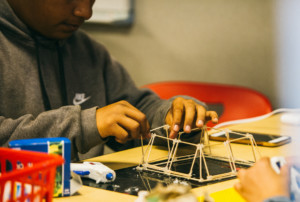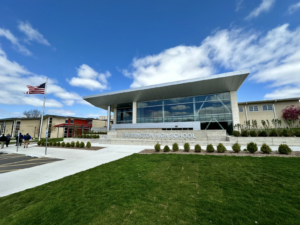Leading With Intention: Innovation and Insight

By: Becky Hutchinson
Becoming a superintendent in the middle of a pandemic was not something that has ever been on my list of career goals. However, when our district faced a leadership change in this critical year, I knew I had to step up. We had taken so many steps forward in the last four years, going backward was not an option nor was fear and instability in the face of so many unknowns.
This has been an extremely challenging year. Yet in our school district, benchmark math assessments are indicating students are performing better than they did in 2019-2020. Despite everything going on, more than 50% of our staff has volunteered this year, of all years, to do an additional 30 hours of professional development. On top of that, 62% of our staff has indicated they want to come in for a week this summer to participate in a Summer Curriculum Summit, where we plan to build units collaboratively using what we’ve learned this year. We haven’t gone backward — in fact, we’ve made a big leap forwards!
How did this happen? I have so much to learn, but after six months there are several things I know. 1. Despite the challenges, our achievement scores and social-emotional learning engagement continue to improve 2. I am fortunate because our teachers and families have become a community of learners focused on the best interest of our students. If you are a school leader like me, here are things you can do to take innovative strides forward.
I am a product of the leadership, change, education, and self-help sections of the library. I am always reading and committed to learning. There are many authors that have influenced me. Simon Sineck, Brene Brown, Chip, and Dan Heath, and my very first non-educational leadership book Permission to Screw Up by Kristin Hadeed. My first mentor, Evelyn Webster, handed me a stack of books and said all kids can learn and all problems can be solved if you are willing to work and research. I carry that with me today, and I believe leaning on the knowledge of these leaders has helped our district move forward in the middle of this crisis. There isn’t a formula or a certain percent of this and that, but there are three frames of thought I have mashed together and set as critical.
1. Start with WHY. First, every single decision you make as an organization should fit your WHY. Your WHY explains you. It explains why you’d do what you do. In 2018, our district went through Simon Sineck’s work of finding our WHY. “We passionately believe in our students so they shatter expectations.” As a leader of the work in our district, I have expanded that to include our staff.
Without exception, I believe with every fiber of my being that my teachers are and will continue to do great things together. Some days I believe in them so much it hurts. I know my teachers are willing to work tirelessly to reach one more target or grade one more mastery check. They hold themselves to such high expectations. As a leader, I must help them feel comfortable with growth and imperfection because being brave enough to attempt learning and implementing new things is shattering expectations. This includes everyone. Those that lead progress, those that question the work, and those that are grasping the status quo. I pour my energy into getting them whatever they need to grow and learn out front of the change or vastly behind it.
2. Be vulnerable. The second frame of mind that is so important when leading innovation is being vulnerable and being willing to screw up. Changing the status quo is hard, and we are going to get it wrong. We are going to need help. We are going to be scared and make people mad. If I am not the first person to own that no one else will and change will not happen.
One example of that is making videos. It sends panic to think about my face on screen forever, but I was asking teachers to do just that, so I had to break the ice. I had to be vulnerable too. I made training videos for teachers and parents. I sent video welcome messages. Our Virtual Open House was amazing!! We just all put ourselves out there for our community; it was so genuine, authentic, and well-received.
Beyond being vulnerable with videos, it is important to be vulnerable as a person. When I am vulnerable as a person, I am my most authentic self. Brene Brown’s work of being brave and authentic allows me to see past walls of prior conflict, see-through and understand anxiety and fear, stand with people when it is hard, and most importantly admit when I am wrong. I can see my own constraints so they do not become my district’s constraints, and I can ask for help. It is not easy, but if I don’t admit all of our professional development prior to right now was subpar and needed to be improved why would teachers look at their data and consider a change.
3. You cannot lead what you do not know. The last frame of mind that is critical is understanding you cannot lead what you do not know and if you would not implement it yourself then you should not ask a teacher. Last spring when it appeared that I may have the opportunity to become the superintendent. I dove into research. My gut told me there must be a way to efficiently work towards our district goals and meet some of the challenges that the COVID-19 crisis was going to present for us.
I stumbled across Jennifer Gonzalez’ blog Making Great Screencast Videos written with Kareem Farah. That article led me down a rabbit hole of research on the Modern Classroom Project and eureka I had found the answer. The Modern Classroom Project was a great mix of blended learning, self-paced learning, individualized student attention, relationships, motivations, building student efficacy, mastery-based learning, and the list went on. However, I felt I could not possibly ask the staff to try this huge shift. It was such a big change, and we were in the middle of a pandemic.
Yet, I could not let it go, so I thought I would put it out there as an option. I would learn with them. We all took the free course together. I began converting our professional development sessions into self-paced units housed on a professional learning website. I allowed them to experience learning virtually. I then completed the Modern Classrooms Project mentorship program with our cohort of sixteen. At the completion of the mentorship program, I had a better understanding of how I could deliver professional development that facilitated educator choice, self-pacing, and any time learning through leveraging mastery-based, blended instruction. I could now provide feedback to teachers about their progress on the skills they wanted to work on versus the old model of talking to all of them for sixty minutes covering the same topic while they graded papers. Moving forward, our professional learning will continue to utilize the Modern Classroom Project framework so teacher learning continues to transform and become more dynamic. Additionally, I will be able to support our teachers through modeling and shared experiences.
As teachers continue to make instructional changes, I know what it would take because I am doing it too. I know the power of the Modern Classroom Project framework, and I know the grace that is needed to grow with the model. It is so incredible how in less than six months, in a pandemic, while teaching face to face and virtual students over thirty-five percent of our staff are implementing a brand new instructional format at a very high level.
Now I am thinking about the next steps. How do I continue to support them? How do I build their connection to other educators? How do I help them share their amazing work? How do I help them lead others? They need to get out there. You need to hear about their work, it is a gamechanger. So today, I took the first step towards what is next. I modeled putting myself out there to connect with others and share my work despite the voice in my head saying “no one wants to hear what you have to say”. I opened the door to my vulnerability and my work, so they could feel safe in doing it because they shatter expectations every single day and you need to hear how they get it done. Whatever challenges arise next, I know my three leadership frames will help my teachers and I surmount them.
For more, see:
Becky Hutchinson is the Superintendent of Concord Community Schools.
Stay in-the-know with innovations in learning by signing up for the weekly Smart Update.






0 Comments
Leave a Comment
Your email address will not be published. All fields are required.